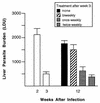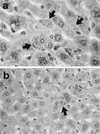Suppression of posttreatment recurrence of experimental visceral Leishmaniasis in T-cell-deficient mice by oral miltefosine
- PMID: 11036063
- PMCID: PMC101643
- DOI: 10.1128/AAC.44.11.3235-3236.2000
Suppression of posttreatment recurrence of experimental visceral Leishmaniasis in T-cell-deficient mice by oral miltefosine
Abstract
T-cell-deficient nude mice infected with Leishmania donovani were treated with miltefosine and then given either no treatment or intermittent miltefosine. Intracellular visceral infection recurred in untreated mice but was suppressed by once- or twice-weekly oral administration of miltefosine. Miltefosine may be useful as oral maintenance therapy for T-cell-deficient patients with visceral leishmaniasis.
Figures


Similar articles
-
Visceral leishmanicidal activity of hexadecylphosphocholine (miltefosine) in mice deficient in T cells and activated macrophage microbicidal mechanisms.J Infect Dis. 2000 Feb;181(2):795-9. doi: 10.1086/315268. J Infect Dis. 2000. PMID: 10669380
-
[Treatment of visceral leishmaniasis: efficacy and limits of miltefosine].Sante. 2001 Oct-Dec;11(4):257-8. Sante. 2001. PMID: 11861203 Review. French. No abstract available.
-
Oral combination of eugenol oleate and miltefosine induce immune response during experimental visceral leishmaniasis through nitric oxide generation with advanced cytokine demand.Cytokine. 2021 Oct;146:155623. doi: 10.1016/j.cyto.2021.155623. Epub 2021 Jun 16. Cytokine. 2021. PMID: 34144446
-
Effect of Pam3Cys induced protection on the therapeutic efficacy of miltefosine against experimental visceral leishmaniasis.Peptides. 2011 Oct;32(10):2131-3. doi: 10.1016/j.peptides.2011.09.014. Epub 2011 Sep 19. Peptides. 2011. PMID: 21959258
-
Oral miltefosine treatment in children with visceral leishmaniasis: a brief review.Braz J Infect Dis. 2008 Feb;12(1):2-4. doi: 10.1590/s1413-86702008000100002. Braz J Infect Dis. 2008. PMID: 18553005 Review.
Cited by
-
In vitro and in vivo efficacy of ether lipid edelfosine against Leishmania spp. and SbV-resistant parasites.PLoS Negl Trop Dis. 2012;6(4):e1612. doi: 10.1371/journal.pntd.0001612. Epub 2012 Apr 10. PLoS Negl Trop Dis. 2012. PMID: 22506086 Free PMC article.
-
Miltefosine (Impavido): the first oral treatment against leishmaniasis.Med Microbiol Immunol. 2004 Nov;193(4):173-80. doi: 10.1007/s00430-003-0201-2. Epub 2003 Sep 26. Med Microbiol Immunol. 2004. PMID: 14513375
-
Proinflammatory and cytotoxic effects of hexadecylphosphocholine (miltefosine) against drug-resistant strains of Trypanosoma cruzi.Antimicrob Agents Chemother. 2002 Nov;46(11):3472-7. doi: 10.1128/AAC.46.11.3472-3477.2002. Antimicrob Agents Chemother. 2002. PMID: 12384352 Free PMC article.
-
Oral treatment with T6-loaded yeast cell wall particles reduces the parasitemia in murine visceral leishmaniasis model.Sci Rep. 2019 Dec 27;9(1):20080. doi: 10.1038/s41598-019-56647-w. Sci Rep. 2019. PMID: 31882925 Free PMC article.
-
The relationship between leishmaniasis and AIDS: the second 10 years.Clin Microbiol Rev. 2008 Apr;21(2):334-59, table of contents. doi: 10.1128/CMR.00061-07. Clin Microbiol Rev. 2008. PMID: 18400800 Free PMC article. Review.
References
-
- Cascio A, Gradoni L, Scarlata F, Gramiccia M, Giordano S, Russo R, Scalone A, Camma C, Titone L. Epidemiologic surveillance of visceral leishmaniasis in Sicily, Italy. Am J Trop Med Hyg. 1997;57:75–78. - PubMed
-
- deRossell R, deDuran R, Rossell O, Rodriguez A M. Is leishmaniasis ever cured? Trans R Soc Trop Med Hyg. 1992;86:251–253. - PubMed
-
- Desjeux P UNAIDS. Leishmania and HIV in gridlock. WHO and the UNAIDS WHO/CTD/LEISH/98.9 Add. 1 and UNAIDS/98.23. Geneva, Switzerland: World Health Organization; 1998.
-
- Hernandez-Perez J, Yebra-Bango M, Jimenez-Martinez E, Sanz-Mareno C, Cuervas-Mons V, Pulpon L, Ramos-Martinez A, Fernandez-Fernandez J. Visceral leishmaniasis (kala-azar) in solid organ transplantation: report of five cases and review. Clin Infect Dis. 1999;29:918–921. - PubMed
Publication types
MeSH terms
Substances
Grants and funding
LinkOut - more resources
Full Text Sources

